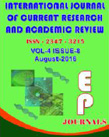Abstract Volume:4 Issue-8 Year-2016 Original Research Articles
 |
Online ISSN : 2347 - 3215 Issues : 12 per year Publisher : Excellent Publishers Email : editorijcret@gmail.com |
2Associate Professor, Department of Psychiatry, Golestan hospital, Ahvaz Jundishapur University of Medical Sciences, Ahvaz, Iran
3Student of General Medicine, Department of Medicine, Student Research Committee, Ahvaz Jundishapur University of Medical Sciences, Ahvaz, Iran
Attention deficit hyperactivity disorder, one of the most common behavioral disorders in childhood. Attention deficit hyperactivity disorder through three primary symptoms including inattention, hyperactivity and impulsivity becomes clear that each child may cause for other disorders. One of these disorders is functional constipation. Fecal incontinence also occurs with functional chronic constipation. The objective of this study was to evaluate the incidence of dification disorders and gastrointestinal symptoms in people with attention deficit hyperactivity disorder. This study was a cross - sectional study in 2014- 2015. The control group of 100 children 4-16 years old at the level of several schools in the city of Ahvaz was randomly selected. And for the people with questionnaires Parent Rating Scale-Revised Conner's (CRSP) for ADHD disorder rejected. The target group of 100 children who were referred to child psychiatry and by tow Child and Adolescent psychiatrists, according to DMS-IV criteria for ADHD has been diagnosed recently and their rankings determined by questionnaire CRSP; Were taken History of constipation and fecal incontinence and symptoms gastrointestinal, such as nausea, vomiting and abdominal pain and demographic questionnaire completed by the researcher for both groups The data were analyzed using SPSS version 22 and chi-square test and P. Value significant amount of less than 0.05 was determined. ADHD was not increasing the risk of dification disorders including constipation and fecal incontinence and gastrointestinal symptoms including nausea, vomiting and abdominal pain. Statistical analysis of each of the variables include constipation :( %35.1 of children with ADHDvs. 23.3 % children without ADHD; P = .06) and fecal incontinence (3.1% of children with ADHDvs. 2.9% of children without ADHD; P =0.94). Abdominal pain (13.4% of children with ADHDvs. 6.8% of children without ADHD; P =0.12). Nausea (3.1% of children with ADHDvs. 2.9% of children without ADHD; P =0.94) and vomiting (1% of children with ADHDvs. 1.9% of children without ADHD; P =0.59). No clear didn't exist association between the prevalence of functional constipation and fecal incontinence and gastrointestinal symptoms including abdominal pain, nausea and vomiting with risk of ADHD.
How to cite this article:
Forough Riahi, Ashraf Tashakori and Maryam Memar. 2016. Prevalence Comparison of Constipation and Fecal Incontinence Associated between Attention Deficit Hyperactivity Disorder in Children referred to a Psychiatric Clinic and Healthy Children in 2014-2015. Int.J.Curr.Res.Aca.Rev. 4(8): 111-121doi: http://dx.doi.org/10.20546/ijcrar.2016.408.010



Quick Navigation
- Print Article
- Full Text PDF
- How to Cite this Article
- on Google
- on Google Scholor
- Citation Alert By Google Scholar
